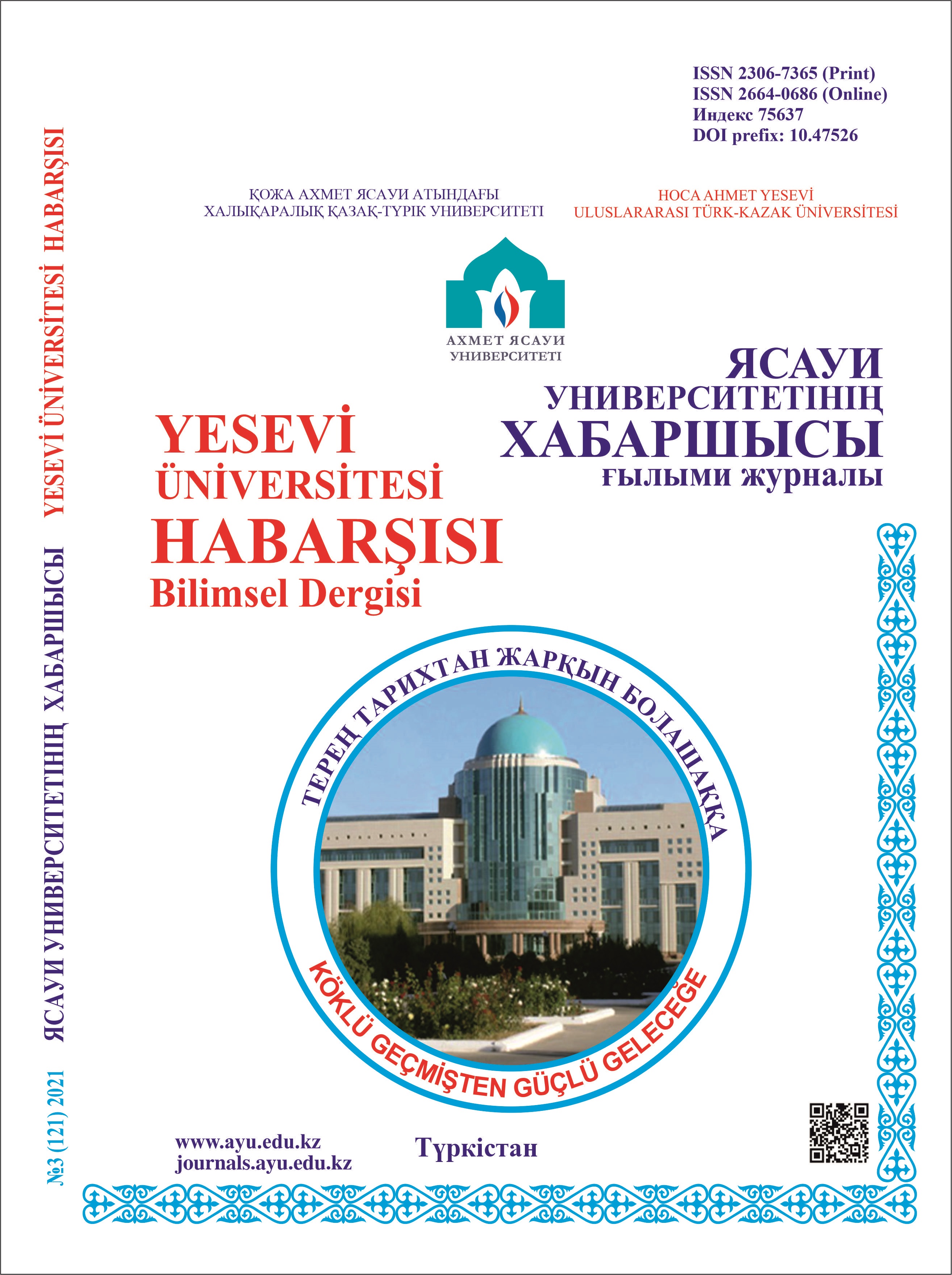Эффективность использования технологии STEAM CLIL в условиях дистанционного обучения
158 75
Ключевые слова:
технология STEAM CLIL, дистанционное обучение, цифровые образовательные ресурсы, отдел механики, двуязычное обучение.Аннотация
В данной статье рассматриваются возможности углубленного изучения научных концепций, развития языковых навыков через дистанционное обучение и адаптации обучающихся к современному миру посредством эффективного внедрения модели STEAM CLIL. Исследование основных факторов, влияющих на эффективность технологии STEAM CLIL, является важным шагом в обеспечении качественного образования и подготовке обучающихся к вызовам информационного общества. Поэтому детально анализируется эффективность методики обучения, которая сочетает элементы STEAM (наука, технологии, инженерия, математика) с методикой интегрированного обучения предмету и языку CLIL (Content and Language Integrated Learning). Исследуется влияние применения образовательных моделей STEAM CLIL в дистанционном обучении на академическую успеваемость обучающихся, их языковые навыки, творческие способности и критическое мышление. Проведен систематический анализ научных трудов, изучены элементы STEAM CLIL и возможности цифровых образовательных ресурсов. Организован педагогический эксперимент, а полученные данные подвергнуты статистическому и математическому анализу. В результате исследования были разработаны и внедрены в учебный процесс цифровые образовательные ресурсы, элементы STEAM и набор заданий, основанных на методике CLIL. Использование результатов исследования и оценка модели STEAM CLIL показали ее значительный потенциал для обогащения образовательного опыта обучающихся. В данной статье предлагаются методологические подходы, способствующие эффективному использованию модели STEAM CLIL в дистанционном обучении и улучшению образовательного процесса на основе научно обоснованных выводов.
Библиографические ссылки
REFERENCES
Şenel M. CLIL and digital natives // International Journal of Languages’ Education. – 2015. – Vol. 1 (UDES 2015). https://doi.org/10.18298/ijlet.461
Capone R., Del Sorbo M.R., Fiore O. A flipped experience in physics education using CLIL methodology // Eurasia Journal of Mathematics, Science and Technology Education. – 2017. – Vol. 13, №10. – P. 6579–6582. https://doi.org/10.12973/ejmste/77044
Kovrizhnykh D.V. Analysis of Teaching Physics Through Interim Language as Preconditions for Humanitarian Training of Science Teachers for Differentiated Approach in CLIL // Journal of Higher Education Theory and Practice. – 2022. – Vol. 22, №8. – P. 19–32. https://doi.org/10.33423/jhetp.v22i8.5312
Nikula T. Hands-on tasks in CLIL science classrooms as sites for subject-specific language use and learning // System. – 2015. – Vol. 54. – P. 14–27. https://doi.org/10.1016/j.system.2015.04.003 5. Rosi F. Content-Specific Learning in CLIL: The case of physics teaching in Italy // EL.LE. – 2018. – №1. – P. 27–49. https://doi.org/10.30687/elle/2280-6792/2018/01/002
Zhetpisbayeva B., Syrymbetova L., Chizhevskaya Y. Interlingual Interference in CLIL Learning // World Journal of English Language. – 2023. – Vol. 13, №8. – P. 100–107. https://doi.org/10.5430/wjel.v13n8p100
Bin Amiruddin M.Z., Magfiroh D.R., Savitri I., Binti Rahman S.M.I. Analysis of The Application of The STEAM Approach to Learning In Indonesia: Contributions to Physics Education // International Journal of Current Educational Research. – 2022. – Vol. 1, №1. – P. 1–17. https://doi.org/10.53621/ijocer.v1i1.139 8. Bai Y., Peng D., Yang J. Design of virtual physics laboratory based on STEAM education // International Conference on Education, Economics and Information Management (ICEEIM 2019). – Atlantis Press, 2020. – P. 18–21. https://doi.org/10.2991/assehr.k.200401.006
Witdiya T., Supriadi G., Supriatin A., Annovasho J. The Effect of STEAM Learning on Improving Each Indicator of Students’ Creative Thinking in Physics Learning // Jurnal Ilmiah Pendidikan Fisika. – 2023. – Vol. 7, №1. – P. 42. https://doi.org/10.20527/jipf.v7i1.7158
Anisimova T.I., Sabirova F.M., Shatunova O.V. Formation of design and research competencies in future teachers in the framework of STEAM education // International Journal of Emerging Technologies in Learning. – 2020. – Vol. 15, №2. – P. 204–217. https://doi.org/10.3991/ijet.v15i02.11537
Bassachs M., Cañabate D., Nogué L., Serra T., Bubnys R., Colomer J. Fostering critical reflection in primary education through STEAM approaches // Education Sciences. – 2020. – Vol. 10, №12. – P. 1–14. https://doi.org/10.3390/educsci10120384 12. Usembayeva I.B., Ramankulov Sh.Zh., Bitibaeva J.M., Moldabekova M.S., Polatuky S. The use of STEAM technology for the development of applied physics teaching // Bulletin of Abai KazNPU. Series Physical and Mathematical Sciences. – 2023. – №4(80). – Б. 277–284. https://doi.org/10.51889/6602.2022.72.66.032 [in Kazakh]
Ramankulov Sh., Choruh А., Polatuly С. STEAM technology as a tool for developing creativity of students: on the example of a school physics course // Iasaui Universitetіnіn habarshysy. – 2022. – №4(126). – P. 200–211. https://doi.org/10.47526/2022-4/2664-0686.17
Shatunova O., Anisimova T., Sabirova F., Kalimullina O. STEAM as an innovative educational technology // Journal of Social Studies Education Research. – 2019. – Vol. 10, № 2. – P. 131–144.
Martyniuk O.O., Martyniuk O.S., Pankevych S., Muzyka I. Educational direction of STEM in the system of realization of blended teaching of physics // Educational Technology Quarterly. – 2021. – № 3. – P. 347–359. https://doi.org/10.55056/etq.39 16. Sulaiman F., Rosales J.J., Kyung L.J. The effectiveness of the integrated STEM-PBL physics module on students’ interest, sensemaking and effort // Journal of Baltic Science Education. – 2023. – Vol. 22, №1. – P. 113–129. https://doi.org/10.33225/jbse/23.22.113
Sagala R., Umam R., Thahir A., Saregar A., Wardani I. The effectiveness of STEM-based on gender differences: the impact of physics concept understanding // European Journal of Educational Research. – 2019. – Vol. 8, №3. – P. 753–761. https://doi.org/10.12973/eu-jer.8.3.753
Yusuf I., Widyaningsih S. W. HOTS profile of physics education students in STEM-based classes using PhET media // Journal of Physics: Conference Series. – 2019. – Vol. 1157. – №3. – С. 032021. https://doi.org/10.1088/1742-6596/1157/3/032021
Asrizal A., Mardian V., Novitra F., Festiyed F. Physics electronic teaching material-integrated STEM education to promote 21st-century skills // Cypriot Journal of Educational Sciences. – 2022. – Vol. 17, №8. – P. 2899–2914. https://doi.org/10.18844/cjes.v17i8.7357
Yunzal A.N. Jr., Casinillo L.F. Effect of Physics Education Technology (PhET) Simulations: Evidence from STEM Students’ Performance // Journal of Education Research and Evaluation. – 2020. – Vol. 4, №3. – P. 221–226. https://doi.org/10.23887/jere.v4i3.27450

